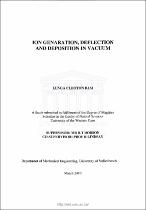| dc.description.abstract | In the PBMR it is known that at high temperatures (above 1250 'C) silver-110m is known to have been released from the TRISO particles and taken up by the helium coolant stream. The released silver-ll0m travels with the helium through the reactor, plates-out on the wall of the power conversion unit and is radioactive with a half-life of 245 days. In order to get a better idea of the dynamic behaviour of silver particles this thesis was initiated with the specific objective of building an experimental apparatus in which silver ions could be generated, deflected and collected on a target plate in vacuum. A literature
study was conducted to find a method to produce the silver ions and resulted in the choice of using an electric arcing method to generate the ions.
Four different silver electrode geometries (ion sources) were developed and tested using different arc voltages in the range of kilovolts to generate the silver ions. The first and second design of the ion source used two flat electrodes separated by a glass insulator, central rod and outer sheet electrodes separated
by glass tube insulator respectively. Both ion sources used arc voltages between
1.0 and 10.0 kV. The ion sources stopped working because of their sensitivities
to high voltage and deposition of silver ions was not observed on the target
plate. The third design of the ion source used two silver needle-like rods with 1.0 mm separation distance. The ion source made use of a very high arc voltage (= 20 kV) because an arc could not be initiated and sustained using the same range of arc voltage used to the first and second design of the ion sources. The
extraction, acceleration, and deflection voltages used were -2.5, -3.0 and 1.0 kV respectively. The results obtained using the third design of the ion source showed that more neutral particles were produced compared to charged particles. This ion source was thus discontinued.
The final (fourth) design of the ion source comprised of a central rod and outer sleeve of silver electrodes separated by a Teflon insulator. With the final design of the ion source sustainable arcs at 2.0 kV were obtained. Deflection voltages used were 1.0, 1.5 and2.0 kV and the extraction voltage used was -3.0 kV. The experimental and theoretical deflection results obtained using deflection voltages of I and 2.0 kV are 2.14 mm and 4.59 mm, and 2.42 mm and 4.88 mm respectively, for an electric field deflection length of 25.0 mm and a target distance from the deflector plates of 10.0 mm. The experimental results so obtained are in agreement with the theoretical results to within ll.67o and 5.97o, respectively. | en_US |

